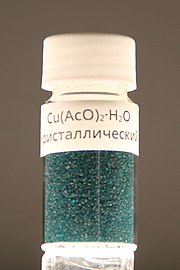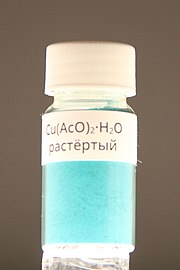Copper(II) acetate
 Small crystals of copper(II) acetate
| |
 Copper(II) acetate monohydrate
| |
| Names | |
|---|---|
| IUPAC name
Tetra-μ2-acetatodiaquadicopper(II)
| |
| Other names
Copper(II) ethanoate
Cupric acetate Copper acetate Verdigris | |
| Identifiers | |
3D model (
JSmol ) |
|
| ChemSpider | |
ECHA InfoCard
|
100.005.049 |
| EC Number |
|
PubChem CID
|
|
| UNII |
|
| UN number | 3077 |
CompTox Dashboard (EPA)
|
|
| |
| |
| Properties | |
| Cu(CH3COO)2 | |
| Molar mass | 181.63 g/mol (anhydrous) 199.65 g/mol (hydrate) |
| Appearance | Dark green crystalline solid |
| Odor | Odorless (hydrate) |
| Density | 1.882 g/cm3 (hydrate) |
| Melting point | 115 °C (anhydrous) [1]
Undetermined (hydrate)[2] |
| Boiling point | 240 °C (464 °F; 513 K) |
| Hydrate: 7.2 g/100 mL (cold water) 20 g/100 mL (hot water) | |
| Solubility | Soluble in alcohol Slightly soluble in ether and glycerol |
Refractive index (nD)
|
1.545 (hydrate) |
| Structure | |
Monoclinic
| |
| Hazards | |
| GHS labelling: | |
   
| |
| Danger | |
| H301, H302, H311, H314, H410, H411, H412 | |
| P260, P264, P270, P273, P280, P301+P310, P301+P312, P301+P330+P331, P302+P352, P303+P361+P353, P304+P340, P305+P351+P338, P310, P312, P321, P322, P330, P361, P363, P391, P405, P501 | |
| NFPA 704 (fire diamond) | |
| Flash point | Non-flammable |
| Lethal dose or concentration (LD, LC): | |
LD50 (median dose)
|
710 mg/kg oral rat[4] |
| NIOSH (US health exposure limits): | |
PEL (Permissible)
|
TWA 1 mg/m3 (as Cu)[3] |
REL (Recommended)
|
TWA 1 mg/m3 (as Cu)[3] |
IDLH (Immediate danger) |
TWA 100 mg/m3 (as Cu)[3] |
| Safety data sheet (SDS) | Baker MSDS |
Except where otherwise noted, data are given for materials in their standard state (at 25 °C [77 °F], 100 kPa).
| |
Copper(II) acetate, also referred to as cupric acetate, is the
.Structure
Copper acetate hydrate adopts the
Synthesis
Copper(II) acetate is prepared industrially by heating
Uses in chemical synthesis
Copper(II) acetate has found some use as an
- Cu2(OAc)4 + 2 RC≡CH → 2 CuOAc + RC≡C−C≡CR + 2 HOAc
The reaction proceeds via the intermediacy of copper(I) acetylides, which are then oxidized by the copper(II) acetate, releasing the acetylide radical. A related reaction involving copper acetylides is the synthesis of ynamines, terminal alkynes with amine groups using Cu2(OAc)4.[15] It has been used for hydroamination of acrylonitrile.[16]
It is also an oxidising agent in Barfoed's test.
It reacts with
Related compounds
Heating a mixture of anhydrous copper(II) acetate and copper metal affords copper(I) acetate:[17][18]
- Cu + Cu(OAc)2 → 2 CuOAc
Unlike the copper(II) derivative, copper(I) acetate is colourless and diamagnetic.
"Basic copper acetate" is prepared by neutralizing an aqueous solution of copper(II) acetate. The basic acetate is poorly soluble. This material is a component of verdigris, the blue-green substance that forms on copper during long exposures to atmosphere.
Other Uses
A mixture of copper acetate and ammonium chloride is used to chemically color copper with a bronze patina.[19]
Mineralogy
The mineral hoganite is a naturally occurring form of copper(II) acetate.[20][21] A related mineral, also containing calcium, is paceite.[21] Both are very rare.[22][23]
References
- ^ "Copper(II) acetate | C4H6CuO4 | ChemSpider".
- .
- ^ a b c NIOSH Pocket Guide to Chemical Hazards. "#0150". National Institute for Occupational Safety and Health (NIOSH).
- ^ "Mineral Safety Data Sheet: Copper (II) Acetate, Monohydrate" (PDF). Archived from the original (PDF) on 2011-09-28. Retrieved 2011-06-14.
- ^ ISBN 978-3527306732.
- S2CID 4292992.
- ^ Wells, A. F. (1984). Structural Inorganic Chemistry. Oxford: Clarendon Press.[ISBN missing]
- ISBN 9780120236206.
- ISSN 0365-110X.
- ISSN 1364-5447.
- ISSN 0567-7408.
- ISBN 978-3642707353.
- ; Collected Volumes, vol. 6, p. 68.
- ; Collected Volumes, vol. 5, p. 517.
- ISBN 978-0-470-84289-8..
- ; Collected Volumes, vol. 4, p. 146.
- )
- ISBN 0471936235.
- ^ Budija, Goran. "Collection of formulas for the chemical,electrochemical and heat colouring of metals,the cyanide free immersion plating and electroplating" (PDF). Finishing.com. Retrieved December 30, 2023.
- PMID 17321784.
- ^ S2CID 97116531.
- ^ "Paceite".
- ^ "List of Minerals". 21 March 2011.
External links
- Copper.org – Other Copper Compounds Archived 2013-08-15 at the Wayback Machine 5 Feb. 2006
- Infoplease.com – Paris green 6 Feb. 2006
- Verdigris – History and Synthesis 6 Feb. 2006
- Australian - National Pollutant Inventory 8 Aug. 2016
- USA NIH National Center for Biotechnology Information 8 Aug. 2016




